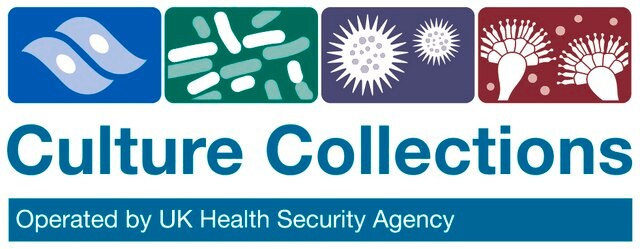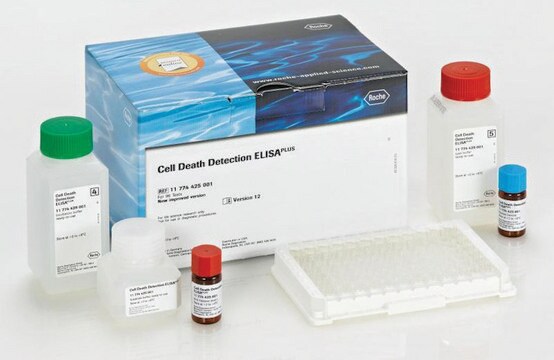About This Item
Kod UNSPSC:
41106514
Polecane produkty
pochodzenie biologiczne
human esophagus
Poziom jakości
tryb wzrostu
Adherent
kariotyp
Not specified
morfologia
Epithelial
produkty
P53 mutation c.455C>T
receptory
Not specified
metody
cell culture | mammalian: suitable
powiązane choroby
cancer
Warunki transportu
dry ice
temp. przechowywania
−196°C
Pochodzenie linii komórkowej
Distal oesophageal adenocarcinoma,
Profil DNA
STR-PCR Data: Amelogenin: X
CSF1PO: 11
D13S317: 11,12
D16S539: 11
D5S818: 10,13
D7S820: 11,12
THO1: 6
TPOX: 8
vWA: 14
CSF1PO: 11
D13S317: 11,12
D16S539: 11
D5S818: 10,13
D7S820: 11,12
THO1: 6
TPOX: 8
vWA: 14
pożywka hodowlana
RPMI-1640:Hams F12 1:1 + 2mM Glutamine + 10% Foetal Bovine Serum (FBS)
Rutyna subkultury
Split sub-confluent cultures (70-80%) 1:2 to 1:5 i.e. seeding at 3 x 10,000 cells/cm2 using 0.25% trypsin or trypsin/EDTA; 5% CO2; 37°C. There is a requirement to change the culture medium every 2-3 days.
Inne uwagi
Additional freight & handling charges may be applicable for Asia-Pacific shipments. Please check with your local Customer Service representative for more information.
Oświadczenie o zrzeczeniu się odpowiedzialności
RESEARCH USE ONLY. This product is regulated in France when intended to be used for scientific purposes, including for import and export activities (Article L 1211-1 paragraph 2 of the Public Health Code). The purchaser (i.e. enduser) is required to obtain an import authorization from the France Ministry of Research referred in the Article L1245-5-1 II. of Public Health Code. By ordering this product, you are confirming that you have obtained the proper import authorization.
Ta strona może zawierać tekst przetłumaczony maszynowo.
Kod klasy składowania
10 - Combustible liquids
Klasa zagrożenia wodnego (WGK)
WGK 3
Temperatura zapłonu (°F)
Not applicable
Temperatura zapłonu (°C)
Not applicable
Wybierz jedną z najnowszych wersji:
Certyfikaty analizy (CoA)
Lot/Batch Number
Przepraszamy, ale COA dla tego produktu nie jest aktualnie dostępny online.
Proszę o kontakt, jeśli potrzebna jest pomoc Obsługa Klienta
Masz już ten produkt?
Dokumenty związane z niedawno zakupionymi produktami zostały zamieszczone w Bibliotece dokumentów.
Donna E Hansel et al.
The American journal of surgical pathology, 29(3), 390-399 (2005-02-24)
Esophageal adenocarcinoma arises through well-defined precursor lesions (Barrett esophagus), although only a subset of these lesions advances to invasive adenocarcinoma. The lack of markers predicting progression in Barrett esophagus, typical presentation at advanced stage, and limitations of conventional chemotherapy result
T Kan et al.
Biochemical and biophysical research communications, 286(4), 792-801 (2001-08-25)
Human esophageal cancer cell lines and human esophageal cancer tissues were profiled on cDNA microarrays. In esophageal cancer cell lines, KYAE and OE-33 (adenocarcinomas) were distinguished from KYSE series (squamous cell carcinomas). Although SK-GT-4 and TE7 were derived from adenocarcinomas
Jurjen J Boonstra et al.
Journal of the National Cancer Institute, 102(4), 271-274 (2010-01-16)
For decades, hundreds of different human tumor type-specific cell lines have been used in experimental cancer research as models for their respective tumors. The veracity of experimental results for a specific tumor type relies on the correct derivation of the
Nasz zespół naukowców ma doświadczenie we wszystkich obszarach badań, w tym w naukach przyrodniczych, materiałoznawstwie, syntezie chemicznej, chromatografii, analityce i wielu innych dziedzinach.
Skontaktuj się z zespołem ds. pomocy technicznej




